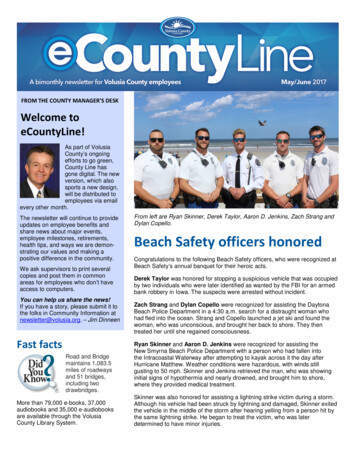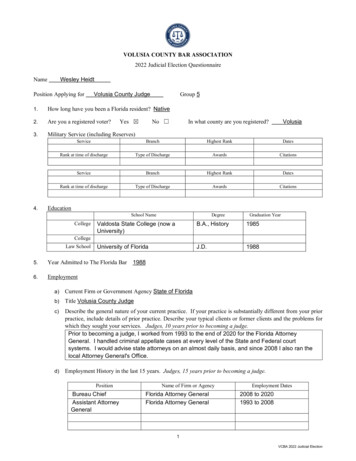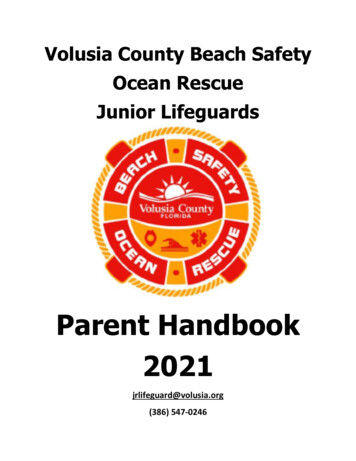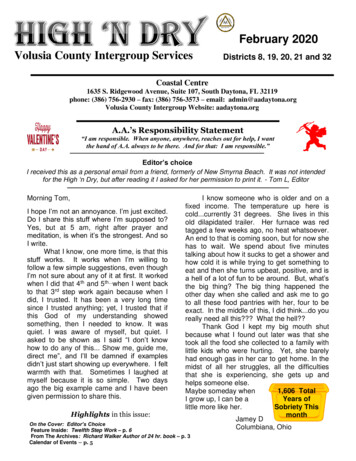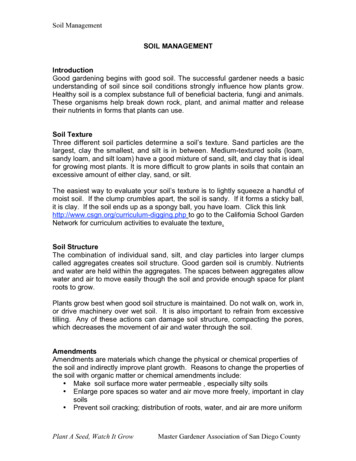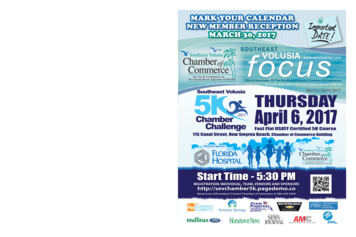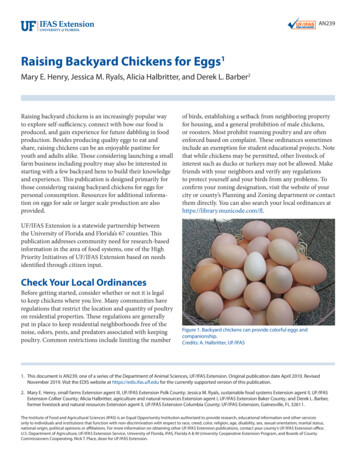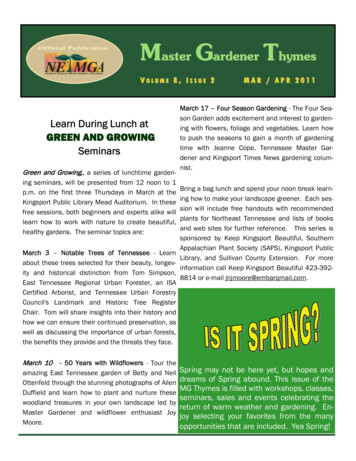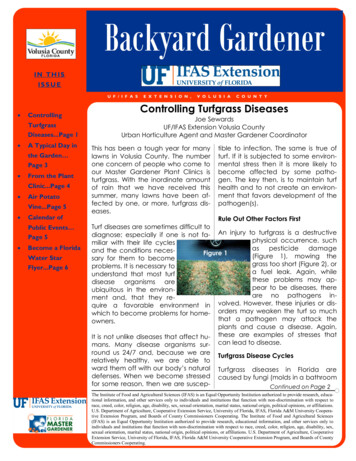
Transcription
Backyard GardenerIN THISISSUEU F / I F A S ControllingTurfgrassDiseases.Page 1 A Typical Day inthe Garden Page 3 From the PlantClinic.Page 4 Air PotatoVine.Page 5 Calendar ofPublic Events Page 5 Become a FloridaWater StarFlyer.Page 6E X T E N S I O N ,V O L U S I AC O U N T YControlling Turfgrass DiseasesJoe SewardsUF/IFAS Extension Volusia CountyUrban Horticulture Agent and Master Gardener CoordinatorThis has been a tough year for manylawns in Volusia County. The numberone concern of people who come toour Master Gardener Plant Clinics isturfgrass. With the inordinate amountof rain that we have received thissummer, many lawns have been affected by one, or more, turfgrass diseases.tible to infection. The same is true ofturf. If it is subjected to some environmental stress then it is more likely tobecome affected by some pathogen. The key then, is to maintain turfhealth and to not create an environment that favors development of thepathogen(s).Rule Out Other Factors FirstTurf diseases are sometimes difficult todiagnose; especially if one is not fa- An injury to turfgrass is a destructivephysical occurrence, suchmiliar with their life cyclesaspesticidedamageand the conditions necesFigure 1(Figure1),mowingthesary for them to becomegrass too short (Figure 2), orproblems. It is necessary toa fuel leak. Again, whileunderstand that most turfthese problems may apdisease organisms arepear to be diseases, thereubiquitous in the environare no pathogens inment and, that they require a favorable environment in volved. However, these injuries or diswhich to become problems for home- orders may weaken the turf so muchthat a pathogen may attack theowners.plants and cause a disease. Again,It is not unlike diseases that affect hu- these are examples of stresses thatmans. Many disease organisms sur- can lead to disease.round us 24/7 and, because we arerelatively healthy, we are able toward them off with our body’s naturaldefenses. When we become stressedfor some reason, then we are suscep-Turfgrass Disease CyclesTurfgrass diseases in Florida arecaused by fungi (molds in a bathroomContinued on Page 2The Institute of Food and Agricultural Sciences (IFAS) is an Equal Opportunity Institution authorized to provide research, educational information, and other services only to individuals and institutions that function with non-discrimination with respect torace, creed, color, religion, age, disability, sex, sexual orientation, marital status, national origin, political opinions, or affiliations.U.S. Department of Agriculture, Cooperative Extension Service, University of Florida, IFAS, Florida A&M University Cooperative Extension Program, and Boards of County Commissioners Cooperating. The Institute of Food and Agricultural Sciences(IFAS) is an Equal Opportunity Institution authorized to provide research, educational information, and other services only toindividuals and institutions that function with non-discrimination with respect to race, creed, color, religion, age, disability, sex,sexual orientation, marital status, national origin, political opinions, or affiliations. U.S. Department of Agriculture, CooperativeExtension Service, University of Florida, IFAS, Florida A&M University Cooperative Extension Program, and Boards of CountyCommissioners Cooperating.
Disease Control Is Not Simple, Inexpensive orEasy!Continued from Page 1orange or old bread are fungi). Most fungi livingin lawns are totally harmless to plants. In fact,they are beneficial because they decomposethe grass clippingsand old roots. A verysmall number of fungicause plant diseases.It is important to knowthat when a fungalpathogen is not actively attacking theFigure 2plant, it has not disappeared from the turfgrass area. It is simply surviving in the environment in a state of dormancy(like a bear in hibernation) or as a saprophyte(nonpathogenic phase), living off dead organicmaterials in the thatch and soil layers.Disease control recommendations are aimed at(1) altering the environment so it is less favorablefor disease development, (2) suppressing pathogen growth, and (3) decreasing stress onturfgrass. An integrated management programthat includes culturaland chemical methods is the key to preventing and controlling turfgrass diseases.The key to this is to remember the pest/plant relationship triangle.In order for any pestDisease Symptomsto become a problem (this can apply to insectsand weeds as well) three things MUST be present;Try to determine if the active disease sites are as- the pest, a susceptible host and an environmentsociated with environmental characteristics, such that favors development of the pest. If you takeas excessive shade, fertilizer application timing, away ANY one of the three criteria, then infectype of fertilizer, soil type, or excessive irrigation. tion cannot occur. For example, if you are conUse these records to help predict disease out- tinually battling large patch fungus (Rhizoctoniabreaks and to design effective management solani, which can affect all common lawn spestrategies.cies in Florida), you first must understand its lifecycle. It is active during cooler weather (fromThere are two common patterns of turfgrass dis- about mid-September to mid April). It is also moreease symptoms. One is a circular patch of prevalent in areas that are over-watered, whereturfgrass, either small or large, that is no longer it is somewhat shady and if the turf has been feruniformly green. The second is turf that has spots tilized with a lot of nitrogen, particularly when it ison the leaves. If disease patches are present, ex- cool. These are examples of an environment faamine the leaves and roots in these patches for voring disease development. If you change thecharacteristic disease symptoms and signs environment, the disease will be reduced if not(actual fungal structures) of theeliminated. This would mean cutpathogen.ting back on water and fertilizerduring cooler months, and perhapsMonitoring the weather helps withreducing the shade. Another opdisease prediction and with detertion would be to spray fungicidesmining the necessity of fungicidebut, as long as the conditions favorapplications. If the diseaseing disease development remain,Large Patch Fungusaffected areas are small and thethe fungus will continue to be aweather is not conducive to an epidemic, then a problem.fungicide may not be necessary, or only spot applications may be required. However, if the long- In many ways, applying pesticides (in this case aterm weather forecast is conducive to develop- fungicide) is merely treating a symptom. Diseasesment of a disease that routinely occurs in the are problems in and of themselves but, they arearea in specific landscapes, then a fungicide also symptomatic of growing conditions that famay be useful in preventing an outbreak.vor disease and not plant (turf) growth. Changing the conditions to favorContinued on Page 32
Continued from Page 2turf development is, in the long run, a less expensive and more sustainable solution. Besides,most modern fungicides that are labeled for turfare expensive to apply.386-822-5778. You can e-mail them at:mastergardener@volusia.org. You can also visitthe University of Florida Electronic DocumentInformation Service (EDIS) at: http://edis.ifas.ufl.edu.Cultural Practices are the Key!Controlling turf diseases is not easy. You mustunderstand the nature of the disease, why it is aproblem and perhaps change the way you arecaring for your lawn in order to deal with it effectively. Cultural practices include selectingthe proper turfgrass, mowing at the correctheight, irrigating only as needed and at thecorrect time, balancing nitrogen and potassium in quantity and source, avoiding or reducing excessive thatch accumulation, and preventing or reducing compacted soils. These cultural practices will help save not only your lawn,it will save you time, effort and money!Be sure that you follow UF/IFAS recommendations for watering, mowing and fertilizing. Keeping the lawn healthy is the single best way tokeep diseases minimized. If you do apply fungicides, be sure you are using those that arelabeled for turf and that are also labeled for theparticular disease you have. READ THE LABEL!The label is the law. If you have trouble understanding the label or aren’t sure what productyou should use, call the UF/IFAS Extension, Volusia County Master Gardener Clinic. We canhelp you sort things out. The phone number isMaster Gardener Vision StatementTo be the most trusted resource for horticultural education in FloridaMaster Gardener Program Mission StatementTo assist extension agents in providing research based horticultural educationto Florida residents.A Typical Day in the Garden for an ADD MG GardenerSubmitted by Rich CherryAlways begins the about the same way. A simple "must do" list from the night before (Often asyou will see, the SAME list as the day before!)Starts with an encouraging walk out the front door. Plan to check out the white water fountain.continues to trip the GFI circuit. (Mosquito breeder!) Quickly notice that weeds have begun to "blossom" in the herb garden pots by the front entrance. Ok, just a few minutes on this.Not a problem.About 60 minutes later.Oh, I'll never get this finished! The heat is whipping me down. Need toget to that water fountain.On the way, notice fire ant hills thriving in the grass. Fortunately, I have fire ant killer in a shakercan in the garage. (15 minutes search locating shaker can) Notice that irrigation tubing in garage is all tangled up. Simple project here.just wrap and store (requires moving several boxes,other hoses.45 minutes.) Shaker can is almost empty.find Fire Ant Killer in aluminum bag.When searching, find liquid "permanent green stain" fertilizer and remember that herbs havenot been fertilized for a long time. Now to find the hose-end sprayer. (20 minutes later.)Starting to cloud up, wondering if it will be a waste to fertilize today. Write it instead on tomorrow's "Must Do" list.Let's see.what was I going to do out here today? And so it goes.3
From the Plant ClinicWe Get CallsSubmitted by Jean PorterRight Plant, Right PlaceQ: I planted a coontie and now it is getting larger than I thought it wouldA: A coontie will mature to 1–3' tall and maybe more. Recommended reading; University of FloridaWeb site: www.solutionsforyourlife.com, and search Florida Coontie bulletin ENH 117. Broken ordead leaves can be pruned 1/4” above ground level. Avoid removing healthy green leaves asmuch as possible to prevent damaging the coontie palm's health. You may consider moving thiscoontie to a different location where it can reach its ultimate growth.Hawk Doesn't Like The Taste:I was watching a hawk fly over with something green and red in its mouth.I thought it was a bird or a snake. The hawk didn't get very far when he dropped it.In checking it out, I was astonished to see that it was one of my wife's gardening gloves. She had put iton the top of a fence to dry. Guess it didn't taste very good.Magnolia Takes It Time:Q: My magnolia is 4 years old. It had a few blooms last year, but none this year. The leaves arehealthy and the tree has grown to 15' tall.A: Most magnolia trees bloom at 10-15 years of age and a few cult iv ar s may bloom earlier. Anyblooms before that are a plus to enjoy.Asian Scale:Q: There is a white substance all over my Sago PalmA: Your sago palm is probably experiencing an infestation of Asian Aulacaspis Scale. Coffee seems tocontrol Asian Aulacas[is Scale. Spray the fronds top and bottom with the coffee and scatter thegrounds on the ground under the tree. The coffee liquor will control the scale already on the leavesand the coffee grounds under the tree will prevent the new larva from climbing up the trunk.Also, we have found that the most consistently effective treatment for controlling the cycad aulacaspis scale insect has been spraying them with oils. We have been using fish oil emulsion, but oneof our colleagues has been using a petroleum-based horticultural oil with good results.We mix the fish oil with water at a rate of 1 part oil to 100 parts of water.Love My Fig:Q: My fig tree was looking and growing great. Then it started getting brown spots and the leaves felloff.A: Your fig tree apparently has fig rust on the leaves. To control fig rust, spray your fig leaves with Bordeau Mix or copper sulfate and lime following directions on the container. Look for a rust freesummer and figs in the fall.4
Air Potato VineDioscorea BulbiferaSubmitted by Marlene DruschelI live in a HOA in Daytona Beach. I was taking a walk when I noticed this huge vine on a neighbor’stree. Since I am from western Pennsylvania, I thought it was Kudzu, because I have heard so muchabout that invasive vine.I contacted Joe Sewards at the Volusia County Agricultural Center and he told me to send pictures ofthe vine, which I did. He responded that it was air potato vine and he suggested that i go on the University of Florida IFAS web site and search for brochure #EENY-547, http://edis.ifas.ufl.edu/in972. It has awealth of information about potato vine and I discovered that I could order the air potato leaf feedingbeetle if needed.I went back to my original site and discovered that the beetles were present and happily eating away.I submitted photos of the vine along with GPS coordinates and sent the info to Paul Pratt at the USDA.He and his team are monitoring locations where the beetle is present.Now, I am checking out my entire HOA, including the golf course and am submitting my findings toPaul. I hope this information is helpful to you.If you are interested in obtaining some air potato leaf beetles, there is currently a waiting list but, theyare available, for free. You can find out more about the air potato leaf beetle and find the form withwhich to order them at: ol.shtml.Calendar of Public EventsTopicDateLocationWelcome to Florida—We Garden DifferentlyOrmond Beach Library Plant ClinicVegetable GardeningMaster Gardener Plant ClinicSugar Mill Garden Q & A and WorkdayStrawberries at Home and Strawberry Plant SaleFNGLA Landscape ShowSeptember 4, 1-2:30 pmSeptember 8, 10 am—12 nSeptember 13, 10—11:30 amSeptember 16 , 1-2 pmSeptember 17, 9-11 amSeptember 20, 10am—12 nSeptember 25-27, 8am—5 pmDeBary Hall (1.5 CEUs)Ormond Beach LibraryDeBary Hall (1.5 CEUs)New Smyrna Beach LibrarySugar Mill Garden, Port OrangeAg Center—Deland 5.00Orange County Convention Ctr.For more details Master Gardeners should check the VMS calendar.The general public may contact the Volusia County Agricultural Center.Volusia County Agricultural Center3100 E. New York Ave. (S.R. 44),Deland, FL 32724At the Volusia County Fair GroundsWest Volusia 386-822-5778 Daytona Beach 386-257-6012 New Smyrna Beach 386-423-3368Like Us On Facebook ntyExtension5
Master Gardeners canattend the training forCEUs and would notneed to take the examsince they would not beseeking certification.6
breaks and to design effective management strategies. There are two common patterns of turfgrass dis-ease symptoms. One is a circular patch of turfgrass, either small or large, that is no longer uniformly green. The second is turf that has spots on the leaves. If disease patches are present, ex-
